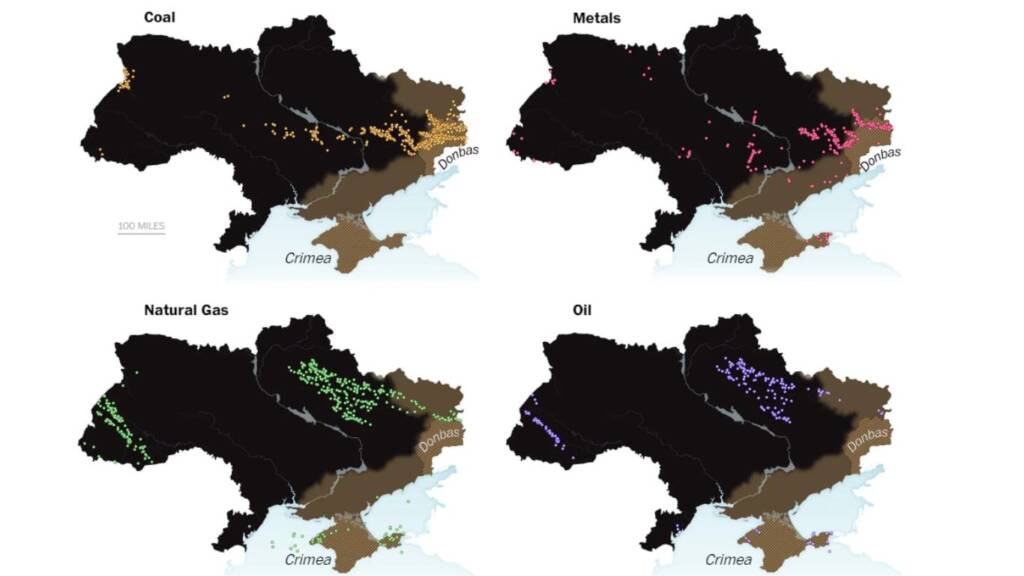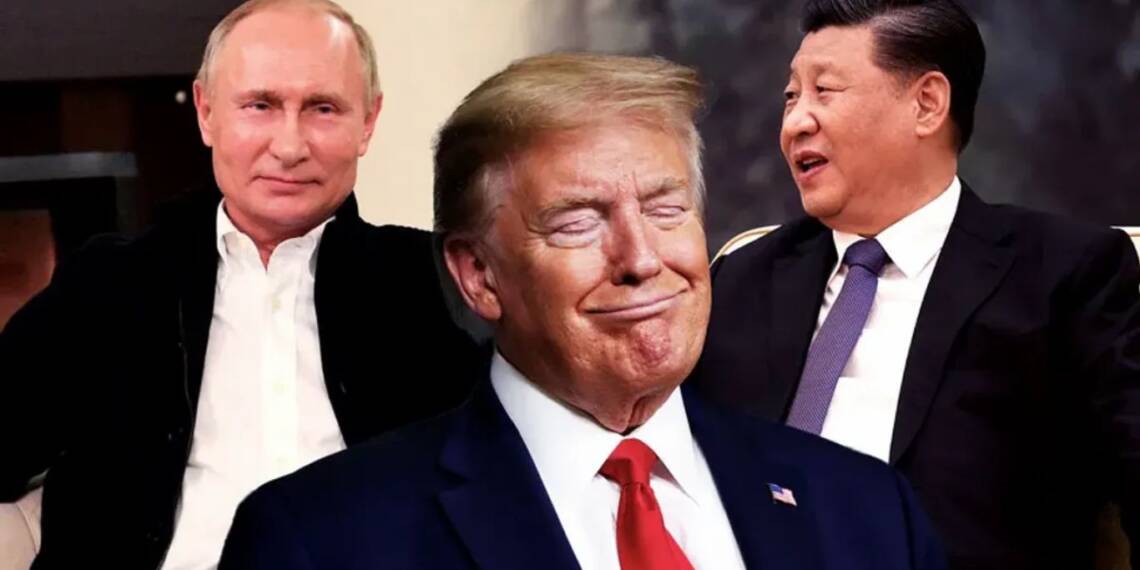The race to cut up Ukraine is fast heating up. First the invasion of Russia drained Kiev of its resources and now Donald Trump and the US seem to be demanding the Rare Earth minerals of the country as payback for its aid during the war, as well as a negotiating tactic to open up any dialogue for a peace deal. The situation is further complicated by the fact that Russia seems to now be in control over the vast majority of Kiev’s mineral wealth.
Ukraine is in a mess and how. The US President Donald Trump who has long been against the aid being given to Ukraine during the war with Russia now has his eyes fixed on Kiev’s Rare Earth’s as payback for all the money US has invested in the country under the floundering Biden regime. “Ukraine has very valuable rare earths. We’re looking to strike a deal where Ukraine secures what we’re giving them with their rare earths and other things,” he said.
Zelensky is now in a tight spot and with hardly any room to maneuver the Ukraine President seems to be angling towards a compromise with Washington. Zelensky has indicated an openness to “investment” from allies—so long as it strengthens Ukraine’s fight against Russia. He confirmed that discussions on rare earth minerals had started months ago. “I talked about this back in September when we met with President Trump,” he revealed.
On the other hand Russian President Vladimir Putin seems to have played his early gambit extremely well. Russia’s calculated focus on the resource-rich provinces of Donetsk, Kherson, Luhansk, and Zaporizhzhia, together with Crimea and the Black Sea, seems to have paid off in a huge way. These marine areas and border territories, abundant in hydrocarbons and critical minerals such as graphite, lithium and uranium, are not only a key area of conflict but also to Europe’s energy independence and the competition between the United States and China for technological dominance.
Russia now holds roughly 20 percent of Ukraine that it has occupied since 2022. The likely peace deal will angle towards a demilitarized zone between the nations, as Moscow will in no way give up the territories it has annexed while the US will look to exploit the resources left with Kiev,
Ukraine’s Rich Resources
Ukraine is considered to possess one of the biggest global reserves of critical minerals. Prior to the 2022 Russian invasion, Ukraine registered 20,000 deposits (8,700 of them proven) of ore-bearing minerals, including 117 of the 120 most globally used metals and minerals. Ukrainian and international authorities reported that the country was home to the world’s top recoverable coal, gas, iron, manganese, nickel, ore, titanium, and uranium reserves.
Ukraine has also been among the largest suppliers of noble gasses such as neon (for micro-chip-making) and boasted the most significant known lithium and rare earth deposits in Europe. Although it must be noted that most of these minerals are in the hotly contested regions of Luhansk, Donetsk, Zaporzhizhia, and Dnipropetrovsk.

These critical minerals and Rare earths are considered essential for various modern technologies, including batteries, magnets, catalysts, and electronic components and a a staple in a variety of sectors such as consumer electronics, healthcare, transportation, power generation, petroleum refining, and defense technologies. Nations across the world rely on essential critical raw materials such as nickel, lithium and aluminium. The market for critical minerals has doubled to over $320 billion in the last five years and is expected to double again in the next five.
Ukraine’s diverse geological zones make it a top 10 global supplier of mineral resources, holding around 5% of the world’s total. The east European nation has approximately 20,000 mineral deposits covering 116 types. Before the Russia war, 3,055 of these deposits (15%) were active, including 147 metallic and 4,676 of non-metallic mineral deposits.
Ukraine is a key potential supplier of rare earth metals, including titanium, lithium, beryllium, manganese, gallium, uranium, zirconium, graphite, apatite, fluorite, and nickel. Despite the war, Ukraine holds the largest titanium reserves in Europe (7% of the world’s reserves). It is one of the few countries that mine titanium ores, crucial for the aerospace, medical, automotive and marine industries.
Before February 2022, Ukraine was a key titanium supplier for the military sector. It also has one of Europe’s largest confirmed lithium reserves (estimated at 500,000 tons), vital for batteries, ceramics, and glass. Ukraine is the world’s 5th largest gallium producer, essential for semiconductors and LEDs, and has been a major producer of neon gas, supplying 90% of the highly purified, semiconductor-grade neon for the US chip industry.
Ukraine boasts confirmed deposits of beryllium, which is crucial for nuclear power, aerospace, military, acoustic and electronic industries, as well as uranium, which is essential for nuclear and military sectors. Zirconium and apatite are vital for nuclear and medical production. The country is also known for its substantial, high-quality iron ore and manganese reserves, which are crucial for green steel production. Ukraine supplied 43% of the EU’s steel plate imports in 2021.
Additionally, Ukraine holds significant reserves of nonferrous metals such as copper (4th in Europe), lead (5th), zinc (6th), and silver (9th). Nickel deposits (215 thousand tons) and cobalt (8.8 thousand tons) are found in the secure Kirovohrad and Dnipropetrovsk regions. Ukraine’s graphite reserves represent 20% of global resources. The country also ranks among the top 10 globally for minerals, including bromine, magnesium metal, manganese, peat, pig iron and kaolin, among others.
The country is home to 20 critical minerals and metals, positioning it as one of the top 10 global suppliers with approximately 5% of the world’s total supply.
Ukraine’s critical materials are valued at US$12 trillion, based on estimates that highlight the potential to expand the global market for raw materials. If we include other natural resources like coal and natural gas, this figure rises to US$26 trillion.
Russia’s Control
Russia has seized control of the majority of Ukraine’s mineral resources, with the highest concentrations located in the Donetsk, Dnipropetrovsk, and Luhansk regions. These resources are worth trillions, according to Forbes Ukraine.
A little more than half of Ukraine’s mineral resources, valued at more than $7.5 trillion, are contained in the four regions Russian President Vladimir Putin annexed in September 2022, and of which his army occupies a considerable swathe. That includes Luhansk, Donetsk, Zaporizhzhia and Kherson, though Kherson holds little value in terms of minerals. The Crimean peninsula, annexed and occupied by Russian forces in 2014, also holds roughly £206 billion (about $258 billion) worth of minerals. Dnipropetrovsk Oblast, which borders the largely occupied regions of Donetsk and Zaporizhzhia and is threatened by the advancing Russian army, “contains an additional $3.5 trillion in mineral resources,” The Independent explained.
Not only is a huge amount of Ukraine’s mineral resources in Russian hands, a lot of it is so close to the front lines that mining, processing and transporting it would be virtually impossible. For example, a major lithium reserve “is within 10 miles of the front line in the Donetsk region,” The Washington Post noted. “Analysts have estimated that Moscow has already managed to seize control of more than $12 trillion worth of Ukrainian energy assets, metals and minerals.”
China’s Role
China has attained global dominance in critical minerals through strategic long-term investments, industrial policies and advantages such as lower labour costs and more lenient regulations. This control extends to 85-90% of global rare earth elements from mining to refining and 92% of global manufacturing of rare earth element magnets.
Ukraine is the world’s fifth-largest producer of gallium—essential for semiconductors and LEDs—and a key supplier of neon gas, providing 90% of the US chip industry’s needs. Russia’s full-scale invasion triggered a global neon shortage, disrupting US chip manufacturing.
The country also holds deposits vital to the nuclear industry, including 1% of global zirconium production and significant beryllium and uranium reserves. Beryllium is crucial for nuclear power, aerospace, military, acoustic, and electronic industries, while uranium remains essential for both nuclear energy and defense applications.
US President Donald Trump’s interest in Ukraine’s critical materials is likely driven by China’s dominance in the rare earth market. As of January last year, China accounted for 60% of global rare earth production and processed about 90%, according to the Center for Strategic and International Studies. Under his “America First” policy, Trump sought to boost US competitiveness by reducing dependence on Beijing.
China’s dominance in critical raw materials enables it to wield geopolitical influence in economic decisions. Over the past 15 years, it has halted exports to Japan, Sweden, and the United States. Rising protectionism further impacts global supply chains for critical raw materials, with some countries, including Zimbabwe and Chile, restricting lithium exports and Indonesia and the Philippines tightening control over nickel exports.
Now with Donald Trump indicating that he is also keen on getting the US involved in the mineral loot of Ukraine, Trump and the US are eyeing Ukraine’s rare earth minerals while Putin is already in control of the majority of its mineral wealth. Many companies are now vying for their piece in the pie while China has taken the centrestage in many markets due to the clash.
However may be future division of Ukraine, one thing is for certain Kiev is bound to be the loser in this entire struggle. Not only has its lost massive swathes of territory, the result of this conflict is that its vast resources are now up for exploitation by the major global players, being cut up and distributed like a cake amongst the victors, and all Volodymyr Zelensky can do is watch as his nation is picked apart due to a rather pointless war, that will end up taking almost everything from his nation.








